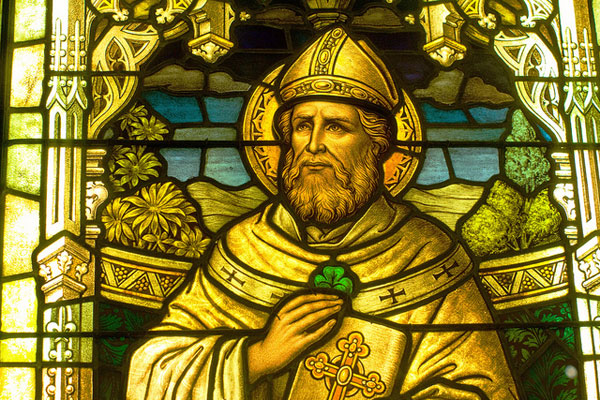St Patrick’s Day is the national holiday in Ireland honoring the Irish Patron Saint, Saint Patrick. It is a day when the world celebrates everything Irish. It is estimated that there are approximately 70 million people worldwide who are of Irish decent. Our unique culture has spread throughout the world earning us a reputation as the world most loved nation.
Today as the world turns green. Rivers, fountains, national and historic monuments around the world celebrate Ireland. The world wears green with shamrocks and leprechauns brought to life in a celebration that is filled with fun, laughter and parades. There is no doubt that we as a nation have won the hearts of the world. March 17th, 461AD is said to be the historic date of St Patrick’s death.
The Founder Of Saint Patrick’s Day, Father Luke Wadding.
Luke Wadding was a Franciscan Friar who was born in Waterford, in the year 1588. He studied in Lisbon and at the University of Coimbra. After he completed his studies he became a Franciscan Friar in 1607 and was ordained a priest in 1613. He established the College of Saint Isidore, in Rome, which educated Irish Priests. He bestowed on the college 5.000 books for its library and approximately 800 manuscripts. He supported the Irish Catholics during the Irish Confederate Wars. His College was an advocate for the Irish Cause within Rome.
It was through the efforts of Father Luke Wadding that St Patrick’s Day became a recognized feast day that is now celebrated throughout the world. Wadding left a lasting legacy that lives on throughout the world.
Father Luke Wadding died in 1657, and is interred within the church of The College of Isidore, Rome. During the 1950’s a statue of Father Luke Wadding was erected on the Mall in Waterford City, however a statue of Thomas Francis Meagher is now at this on the Mall in Waterford. Luke Wadding’s statue can now be found at the entrance to the Medieval French Church, Greyfriars, within the Viking Triangle in Waterford City.
The Legends of Saint Patrick.
The Shamrock.
At the time when Patrick was converting Ireland to Christianity, Ireland was a nation that was deeply rooted in Pagan Beliefs and the native Irish would have been mainly illiterate. To teach Christian Doctrine and explain the concept of the Holy Trinity, Patrick held up the shamrock, with its 3 leaves symbolizing the Father, Son and Holy Spirit.

This was a very clever idea on Patrick’s behalf, as the Pagan Irish had a deep-rooted belief in the power of nature, as nature was central to their long held belief system. The Shamrock was sacred to the Pagan Irish due to The Shamrock’s regenerative powers, allowing Patrick to convert the Pagan Irish to Christianity through a symbol that was familiar to them and already had a sacred meaning to the Pagans.
The Shamrock has now become central to the legend of Saint Patrick. The Shamrock has become recognized symbol of Ireland and Saint Patrick’s Day throughout the world.
Saint Patrick Banishes Snakes from Ireland.
The Legend states that Saint Patrick was undertaking a 40-day fast on top of a mountain in Ireland, when he was attacked by snakes. Using his staff Saint Patrick banished all the snakes in Ireland into the sea, and from that day Ireland was a land that was free of snakes. This Legend seems to draw on the story of Moses from the Book of Exodus, When Moses and Aaron’s staffs transformed into serpents to battle the Pharaohs scorchers.
It can also be assumed that the banishments of snakes from Ireland, symbolizes the banishment of evil. The Irish Druids and Pagans would have also seen snakes as symbolizing evil. It is however important to state that there is no evidence that there were ever snake in Ireland.
Patrick’s walking stick becomes a living tree.
During a time that is known as, the evangelical travels of Saint Patrick. Patrick was traveling back to Ireland from his homeland in Romano-Britain. He used the aid of an ash wood walking stick, as he was attempting to convert the Native Irish to Christian beliefs, the walking stick that he was leaning on took root and started to grow into a living tree.
Saint Patrick in Irish Mythology.
Ireland has countless myths and legends that have fascinated and thrilled generations of scholars throughout the world. Ireland’s myths and legends play a major role in the establishment of an ancient culture with constant and impermeable ties to the ancients of Ireland, Warriors, Gods, Goddesses and Druid are all part of a culture that gives Ireland its unique and powerful culture that has spread throughout the world.
The most famous Irish Warrior to grace our history books is Fionn Mac Cumhaill the leader of the ancient warriors of Ireland, The Fianna. As the legend goes, Fionn’s Son Oisin left Ireland with his love Niamh on a white horse into the sea to the land of Tir Na Nog.
Upon his return to Irish soil, Oisin had been away for centuries and arrived back in the time of Saint Patrick’s evangelical travels. According to a 12th Century literary work called Acallam Na Senorach, Patrick encountered two ancient Irish warriors of the Fianna, Oisin and Cailte mac Ronain, who had somehow defied time to survive to the age of Saint Patrick.
According to legend Patrick sought to convert these ancient Irish Warriors to Christianity but they were Pagans and had no desire to convert. They told Patrick of the glorious ancients and there lifestyles as warriors and defenders of Ireland.
They told him of their ancient beliefs, battles and their lives connected to nature. The legend says that Saint Patrick transcribed the wondrous legends of Ireland and the exploits of Fionn Mac Cumhaill and the Fianna.
Who was Saint Patrick?
Saint Patrick is the Patron Saint of Ireland, often referred to as The “Apostle of Ireland” and “The First Bishop of Armagh”. He is a fifth century Saint who is of Romano-British origin and his Roman name would have been Patricius, who was the son of a Roman Decarion.
It is not sure exactly where Patrick was from within Roman- Britain; many areas have been suggested including Wales, Scotland and Cumbria. At the age of 16 Patrick was captured by a band of Irish Pirates. We know about this time in Patrick’s life, through the Confession of Patrick.
One of the two literary works that are widely accepted as being written by Patrick, in Latin.
He was held captive for 6 years during which time he worked as a Sheppard. Patrick discovered his close relationship with God at this time. Being of Romano-British origin it is likely that Patrick would have been brought up in the Religion of the Ancient Romans. After his time in captivity he converted to Christianity.
As he tended to his flock in the mountains of Ireland, he is said to have heard a voice telling him he should return to his homeland. He escaped his captures and after a long and difficult journey, he returned to the land of his birth. It took him years and he had many adventures along the way. He eventually found his way to his home, where he continued to study the faith of Christianity.
It is said that while he was at home he had a vision. Thought to be a vision of Saint Victirious, Bishop of Rome, who carried with him in his hand a letter that contained the words “The Voice Of The Irish”. Patrick saw this as a sign that he must return to Ireland. He returned to Ireland after his ordination.
It took time for the Native Irish to accept Patrick and his teachings; he faced many hardships and trials on his mission to convert the Irish from their long held Pagan belief system to the faith of Christianity. He baptized thousands and his message started to spread throughout Ireland.
He began to ordain priests to carry out his teachings on Christianity. He converted Irish Kings and he traveled throughout the whole of Ireland to spread his word. The Confession contains some vague details of this travels around Ireland and the resistance he sometimes faced but he persevered and was successful in his mission to convert the Pagans to Christianity.
The second literary work that is attributed to Patrick is the “Letter to Cororicus”. It is a letter that made public of the excommunication of Cororicus by Patrick. Cororicus had captured many of Patrick’s Christian converts and forced them into slavery. Cororicus is thought to have been a wealthy Roman Britain.
After a long life St Patrick is thought to have died on March 17th 461 although this date is not agreed on by academics. Legend says that he died at the age of 120 and had been preaching in Ireland for 60 years at the time of his death. His burial place is located in Down Patrick in Co. Armagh.
His grave is within Down Cathedral, which is built on the site of a Benedictine monetary dating from 1183. Saint Patrick was never officially Canonized by a sitting Pope, however it is important to note that during this time in history, most Saints were granted the title if they died in martyrdom or were considered extraordinarily holy.

